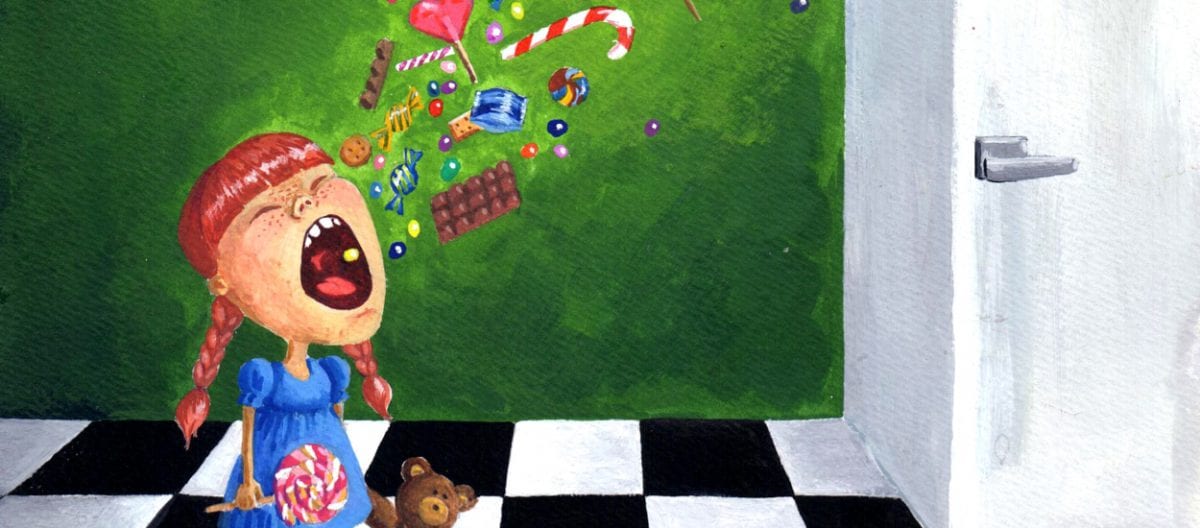This piece is a rebuttal to Should You Let Your Children Have Candy
I’ve been a dietitian long enough to have lived through the low-fat craze, and now, much to my dismay, the era of sugar-phobia. Thanks to fear-mongering headlines that overstate what science actually knows, myriads of parents are freaking out over sugar—the key ingredient of lollipops, cotton candy, and pie that kids have been eating for decades. Now it’s suddenly toxic, poisonous, and the cause of every major disease.
Look, I’m a mom and I care about my kids’ health. I’m also a dietitian—with a professional interest in what and how people eat. I believe in balanced diets and vegetables. I fully understand that eating only cupcakes for lunch every day leaves a lot to be desired nutritionally speaking. I also recognize that kids, given an option, would easily choose a bowl of Skittles over scrambled eggs and toast. But there’s a big leap from “consider the volume of sweets your kids get and strive for balance” to “OMG if you give your kids brown sugar on their oatmeal they’re one-step-away from addiction!” madness that’s happening lately in the media.
I was quoted in an article HERE at the Kars4Kids educational blog for parents recently and, while I stand by my quote, I felt that the tone of the article was unnecessarily negative, inciting fear and guilt in parents instead of hope and direction. Parents are under such pressure to get their child’s eating just right. With social media, moms are constantly feeling one-upped by the moms whose kids eat roasted kale chips like they were fries. Or the kids who gobble down spaghetti squash with more gusto than they have for macaroni. It’s easy for moms to either brush off warnings entirely or let worry take over.
While it is true that health organizations recommend some tight limits for sugar consumption by kids, we have to not miss the forest for the trees. We need to look at the candy issue, and all nutrition issues, in light of a child’s developing relationship with food. Based on my professional and personal experience, I will venture out and say that a child’s relationship to food is more important than what they eat at any given meal or snack.

The original author has graciously given me permission to write a rebuttal, so I wanted to address some of the claims in the article. And no, I am not connected (financially or otherwise) to the “sugar industry,” any food manufacturer or candy company.
What is sugar?
All carbohydrates (bread, rice, pasta, fruit, etc.) break down into sugar via digestion. Yes a sweet potato or quinoa also contains fiber and other nutrients and doesn’t get absorbed at lightning speed the way candy does. But it ultimately turns into the same glucose—give or take.
And this glucose is the body’s preferred energy source. It’s the premium, unleaded gasoline for every muscle and organ in your body. When someone has severely low blood sugar (typically only in diabetes), it affects their brain enough that you could easily mistake them for drunk.

Does this mean we should just skip food and feed our kids straight syrup or candy to keep them adequately fueled? Of course not. There are other nutrients little bodies get from food and in general, eating whole foods provides the most benefit because they contain fiber, vitamins, minerals and other essentials.
Any one nutrient pulled out of a food isn’t going to be as effective in doing its job (usually, there’s always exceptions) as it is when it is eaten as part of a balanced diet. That’s the really neat synergistic effect of eating food instead of just a supplement or combo of individual nutrients. The point is, regardless of what an ideal diet may look like, sugar, is not an unnatural substance or poison or something that somehow confuses our body.
Sugar is only as addictive as oxygen is addictive
Sugar has been likened to cocaine because it happens to light up the pleasure centers of the brain similarly. On the surface, this seems like powerful evidence that it is drug-like and dangerous. However, you know what else lights up our brain? Hugs, laughter, sex—even cuddling cute puppies. But you don’t hear anyone arguing that we should stop watching comedy or quit giving hugs for fear we’ll want to snuggle and laugh 24/7.
There are key differences between dangerous recreational drugs and a natural substance present in many foods. Cocaine is 100% unnecessary for human life and happiness. Nobody who has grown up without cocaine has suffered for the lack.
Sugar, on the other hand, is a ubiquitous part of food and food is necessary for our human life. So in this sense, it makes sense that it is inherently rewarding and pleasurable. If it were not so, we’d not try too hard to do all that hard work of obtaining, preparing and eating several times a day. I also have yet to hear of a sugar lover holding anyone at gunpoint for an ounce of syrup.
The research on food (or sugar) addiction does not match the strength of beliefs in this area. For one, most food addiction research has been done on animals—not people. It’s great to study mice to expand our understanding about how something might function, but it doesn’t mean we can translate the results to humans.
For us humans, eating is a complex biopsychosocial process that is never as simple as “this food is addicting and this food is not.” Finally, few, if any, of the food addiction research, has controlled for history of dieting or patterns of restriction. And it is well known that restricting foods often leads to disinhibited eating of those foods later complicating the very idea of “addiction.”
Kids Have a Natural—Not Pathological—Preference for Sweets
A child’s first food, breast milk, is sweet (so is formula). Nobody has to teach a child to like sweet flavors, it is hard-wired from birth. And until their bones are done growing, it seems most kids will have stronger, more intense sugar preferences than most adults. This seems to suggest a biological drive to get enough calories for growth.
Now take a child with his natural propensity to enjoy and want sweets and add a very health conscious parent who has been scared by the sugar phobia of today and you invariably end up with a child who feels highly deprived. If he’s typical, he’ll overeat sweets every chance he gets, because he might not see them at home for a loooong time.
Candy becomes a very alluring food because it’s so forbidden. Mom sees her child overeats sweets when he gets a chance, reinforcing her belief that he can’t be trusted, so she tightens the reigns some more and thus the vicious cycle continues. Oh, the stories I can tell from friends and acquaintances about how their parents’ sugar restriction led them to become preoccupied with sweets both as kids and adults. Kids whose parents enforce strict cookie limits at events who go off and stuff their mouths with extra cookies when Mom isn’t looking.
Sugar and Teeth—more than meets the eye.
To add to candy’s bad reputation, it’s always implicated in dental caries. But the reality is that any food that sticks to teeth, gets stuck between teeth, or is constantly bathing teeth is an open invitation for cavity-causing bacteria to grow. Whether that’s sticky candy or goldfish crackers or dinner rolls or juice.
What is not talked about enough is the pattern of eating. Anytime kids graze—on anything—those little kid teeth are being bathed in food and more likely to develop cavities. The simple solution to this is 1) Don’t allow kids to GRAZE on anything—keep to regular meal and snack times and 2) Brush teeth every day.
Nibbling on crackers and sipping on juice every 30 minutes is a different beast and a whole lot more damaging to teeth than having a few gummy bears with dinner when a child is eating anyway. Most kids, allowed to graze, could very well nibble themselves into dental disaster. But once again it is not the candy, it is the lack of structure with food.
Feeding Candy and Sweets Responsibly
Nobody is saying to give your kids free access to sweets. But be realistic in how you manage this alluring food and lean on structure—not vilification of candy.
Consider the advice of renowned dietitian and feeding expert Ellyn Satter when it comes to feeding kids:
- Parents need to observe a Division of Responsibility (DOR) for feeding regarding the what, when, and where logistics.
- Parents should concern themselves with choosing a variety of good-tasting food, serving meals (and snacks) at routine times, and make sure kids are seated in a distraction-free eating area (and eat with them when we can).
This behind-the-scenes structure is the bulk of the work we need to do as moms and dads. But, once we’ve set the food on the table, we can relax and trust our kids to take care of the jobs of deciding whether to eat and how much to eat from what we’ve provided. Satter’s advice on foods we generally consider “forbidden” is to include them in meals or snacks—times kids are eating anyway.
This is how we manage sweets in our household. Here’s a practical example: At mealtime, if we happen to have cookies for dessert, each person gets a cookie on or next to their plate at the very start of the meal. GASP!

No, my kids don’t have to earn dessert via 3 bites of vegetables. Doing so would put the cookie on a pedestal while lowering broccoli to “grunt work.” That’s totally not the lesson I want my kids to learn at the table. One small piece of research also showed that kids are willing to eat past fullness to get dessert when it is served at the end of a meal—another reason to level the playing field.
You might have lots of questions about this unconventional method of serving sweets. I will answer a key objection: Isn’t controlling the portion another way to restrict?
Kids can easily just eat several cookies and ignore the rest of the meal. Since that’s not the reason you baked cookies and slaved over the salad and casserole (and good nutrition is still on your mind), it’s okay to limit dessert to one portion with a meal the vast majority of the time. But to make up for this tight control, you will need to rely on some snack time freedom.
Call it Good
Now and then, serve a more-or-less unlimited portion of sweets, toss a glass of milk on the table and call it good. Seriously. The opportunity for your kids to find their own limit with a big plate of cookies, their Easter or Halloween haul, or ice cream on a hot day will be an invaluable lesson!
It will help them feel a sense of autonomy, self-trust, and lower that intense feeling of “I never get enough” that can lead to binge eating, hoarding, and sneaking of favorite foods. You’ll probably be pleasantly surprised to see them leave half-eaten pieces behind once they feel secure in the hope this won’t be their last chance to enjoy a satisfying portion of sweets. And when you serve this ad lib portion at a normal snack time, it won’t interfere with dinner.
Whether my child begs for candy, crackers, french fries or apples, I lean on our house routine. If it’s not time to eat, I’ll say something like “Sounds like you’re hungry, snack time is coming very soon. We will eat then.”
It doesn’t take long for kids to understand the program. No need for a lengthy nutrition explanation. No need to convince or persuade our kids about what they should or should not crave or enjoy eating. No need to scare kids about chemicals—because everything is a chemical. Including sugar-free, dye-free, preservative-free dihydrogen monoxide (H2O or…water).
Teaching Kids about Food & Eating
I really love the tone and care with which the quoted parenting expert spoke about talking to kids. Where I disagree is that when it comes to food, kids need our leadership more than nutrition lessons. Young kids eat based on what tastes good to them and what they suspect might taste good to them. They eat without hang-ups. They eat with reckless abandon and stop-on-a-dime fullness regulation—unless and until we start trying to interfere. Children are also not likely to apply nutrition facts and admonitions to their own eating. Not without bypassing the important development of their food acceptance.
Food acceptance is a skill that starts in infancy, seems to vanish in toddlerhood, and then starts to progress again slowly. For some kids this is a very slow process and requires parents to lead with a routine of meals and snacks, eating together regularly, and maintaining a positive attitude toward all food and eating. Focusing on “oughts” and “shoulds” and “good foods” vs. “bad foods” really interferes with a child’s ability to feel good about eating and trusting themselves around all foods—a necessary skill that is a building block toward a healthy eating life.
Young kids are also very concrete thinkers while nutrition concepts are abstract. They aren’t going to be able to apply the idea of “moderation” or “candy is bad but only when you eat too much.” They can parrot back ideas, but they aren’t going to internalize the meaning and its application. Once again we need to fall back on the DOR to center ourselves and remind ourselves, as parents, that all foods can fit and our kids are trustworthy even with candy when it is served in an organized way.
And frankly, the idea that kids who like candy won’t like other foods like fruit is false. Anecdotally speaking, my kids are perfectly in love with both candy and fruit. And I know countless other kids who are the same. Love for one does not eliminate love for the other. I for one, like chocolate and kale, ice cream and asparagus, Italian soda and salmon—and my mom was more permissive with sweets than I am.
Final Thoughts
Should you let your children have candy? Yes!
Just keep all foods, sweets, and drinks to structured eating times. You don’t have to offer candy daily, but don’t treat it like contraband. By incorporating it in a neutral, normal way you will teach your kids to develop a sustainable relationship with it. Not one of feast or famine. Because, yes, as the original article stated, candy is out there. It’s everywhere. Being able to manage it in a healthy and relaxed way will serve them far more than lessons about the dangers of sugar.

This was a fabulous read! Being that I’m fighting a losing battle against sweets anyway, it’s good to hear that I have this info in my corner :). I remember loving nosh as a kid, but now it makes me nauseous, so there’s hope for my kids.
Thank you, Chana!
Thank you, Chana! 🙂
“Sugar, on the other hand, is a ubiquitous part of food and food is necessary for our human life”
Sugar (refined) is NOT necessary for our human life. The natural sugars found in fruits are part of a healthy diet and perhaps that should be clarified. But refined sugar found in candy, cakes, cookies, etc.. is irrefutably unhealthy and unnecessary.
Strictly speaking, true. Candy, cookies, are not specifically “required” for human life. Neither is Disneyland, nail polish, central A/C, jewelry, make-up, dishwashers, cute clothes, pets and so on. We can live completely ascetic lives and survive. But it’s ridiculous to vilify normal, fun, foods that people eat. Refined sugar is NOT irrefutably unhealthy. I’ve lived over 40 healthy years consuming refined sugar amongst many other foods. There’s a big difference between living on candy and allowing/including candy.
But here’s the thing…what is pretty darn irrefutable is that people WILL eat sweets. Kids are super drawn to sweets and when you make them forbidden for “adult reasons” (that don’t mean much to kids) you will inevitably create a screwy relationship with those foods. Instead of kids growing up to be adults who can manage their sugar eating, kids who are over-controlled tend to grow up into adults who cannot manage their sugar consumption and vacillate between restriction and overeating.
Human nutrition, from the moment we started domesticating plants and vegetables, has suffered from a gradual decline in quality and variety, an unfortunate necessity of our technological and scientific progress. But we also started refining certain foods, sugars, flowers, oils and salt. And the industrial revolution made those really convenient and cheap. And we added pesticides, herbicides, preservatives, hormones and wrapped a lot of it in chemical-residue-laden plastic. Maybe, the increasing rates of obesity, high blood pressure, dental cavities and malocclusion, cancers, and specially diabetes are related to what we eat.
Sugar has only been a part of everyone’s diet for the last 400 years, before it was too expensive or rare (not to mention the untold suffering brought about by colonization and sugar plantations). SUGAR IS NOT NATURAL, ITS CONSUMPTION CREATES AN UNNATURAL METABOLIC STATE IN HUMANS OF ALL AGES AND LEADS TO A MULTITUDE OF CHRONIC HEALTH PROBLEMS. Fortunately, education will change this trend and people will demand more unrefined, nutrient dense food with NO processing and greater variety.